Complex drops and sprays in the nose contain several components. For adults and children in the pharmacy network there are ready-made pharmaceutical products that are safe for use. In some cases, it may be necessary to prepare special formulations according to prescription prescriptions compiled by an ENT doctor.
Record content:
- 1 What are complex nose drops?
- 2 Advantages and disadvantages of complex drops
-
3 What can nasal medications be made of?
- 3.1 Vasoconstrictor substances
- 3.2 Antimicrobial components
- 3.3 Antihistamines
- 3.4 Glucocorticosteroids
- 3.5 Immunomodulators
- 3.6 Saline
- 3.7 Additional components
- 4 Indications for use in children
- 5 Side effects, contraindications
-
6 Pharmaceutical compound drops
- 6.1 How to pick up a child?
- 6.2 Instructions for use
-
7 Recipes for the preparation of combined nasal solutions for children
- 7.1 With adenoiditis and microbial rhinitis
- 7.2 With sinusitis
- 7.3 For rhinitis with antiallergic effect
- 8 Conditions and shelf life of multicomponent drops
- 9 Video about nose drops
What are complex nose drops?
Complex nasal drops for children, the composition of which is described later in the article, are multicomponent mixtures for intranasal use.
There are pharmaceutical preparations ready for direct use, in some cases such drops can be recommended by an ENT doctor for preparation in the prescription department of the pharmacy or at home conditions. The composition of the drug is selected individually, depending on the diagnosis and clinical manifestations.
Advantages and disadvantages of complex drops
The advantages and disadvantages of such funds in comparison with others are listed in the table below.
| Advantages | Flaws |
| High efficiency, comprehensive treatment | Increased risk of allergic reactions and other side effects. |
| There is no need to instill several drugs, since all the components are in one mixture. | Some components may have age restrictions, a wider range of contraindications for the mixture. |
| Possibility of individual selection of the composition | Lack of clinical studies regarding the pharmaceutical composition. |
| High price | |
| The need for strict adherence to the cooking technology, possible mistakes by the medical staff or at home. |
What can nasal medications be made of?
The composition of nasal preparations may include drugs of the following groups:
- antibacterial, antiviral and antifungal components;
- decongestants (vasoconstrictor) agents;
- antihistamines;
- hormonal agents;
- regenerating substances;
- moisturizing ingredients.
Vasoconstrictor substances
Complex nasal drops for children, the composition of which varies depending on diagnosis, most often contain the following vasoconstrictor substances:
-
Xylometazoline, affecting alpha-adrenergic receptors. The effect comes quickly - after 2 minutes. after application. It practically does not enter the systemic circulation. Before the age of 2 years, such drugs are prescribed with caution.
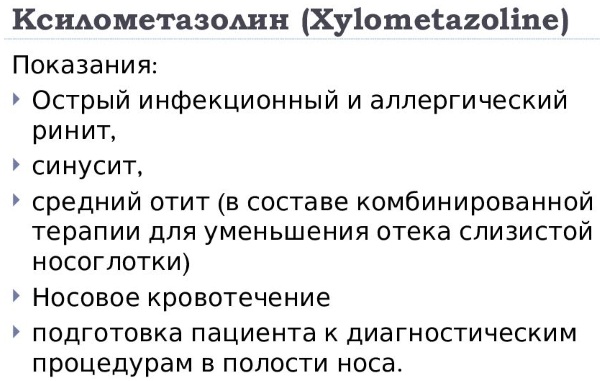
- Oxymetazoline hydrochloride, the effect of which is manifested after 15 minutes. after application and lasts an average of 6-8 hours.
- Naphazoline, having a fast and long lasting effect. In children under 1 year of age, it is contraindicated.
All of these remedies facilitate nasal breathing by reducing swelling of the mucous membranes and improving the removal of phlegm. They can be used both for acute respiratory infections and for allergic rhinitis.
Antimicrobial components
Of the antimicrobial components in the preparations of this group, substances such as:
- Framycetin sulfate - an aminoglycoside antibiotic that has a bactericidal effect. It is active against staphylococci, Klebsiella, hemolyzing Escherichia coli and other gram-positive and gram-negative bacteria. Preparations with its content are prescribed for rhinitis (including those combined with pharyngitis), sinusitis, as well as for the prevention of postoperative complications.
- Neomycin - aminoglycoside antibiotic, which is a natural substance - a waste product of a fungus from the class of actinomycetes. Its principle of action is to disrupt the formation of RNA and proteins in bacteria. In high concentrations, this substance directly damages the membranes of microbial cells, which leads to their death. The drug is active against staphylococci, streptococci, salmonella, shigella, Escherichia coli, corynebacteria, Proteus, the causative agent of anthrax. The active substance is absorbed into the systemic circulation in small quantities, mainly has a local effect.
- PolymyxinIN, which belongs to the group of polypeptide antibiotics. This compound is active mainly against gram-negative bacteria.
- Tiamphenicol, antibacterial effect of which is associated with the suppression of protein production in bacteria. This compound is active against many gram-negative and gram-positive bacteria that affect the upper respiratory tract. Due to the absence of a nitro group in its structure, the number of side effects is reduced, therefore preparations with its content are safe for children.
- Gramicidin, which is part of many drugs for the treatment of tonsillitis, tonsillitis, infectious lesions of the oral cavity. The action of this substance is based on damage to the membrane of microbial cells.
Antihistamines
The following components can be used as antiallergic agents:
-
Azelastine (found in nasal preparations such as Allergodil, Dimista, Momatrino Advance) - H blocker1-histamine receptors. This substance helps to stabilize cell membranes, reduces the permeability of blood capillaries, fluid effusion from them during inflammation (edema), prevents the release of biologically active compounds, including histamine, which contribute to the development of allergic reactions. When applied topically, it has a slight systemic effect, therefore it causes a minimum of side effects. However, this remedy is contraindicated for children under 6 years of age.
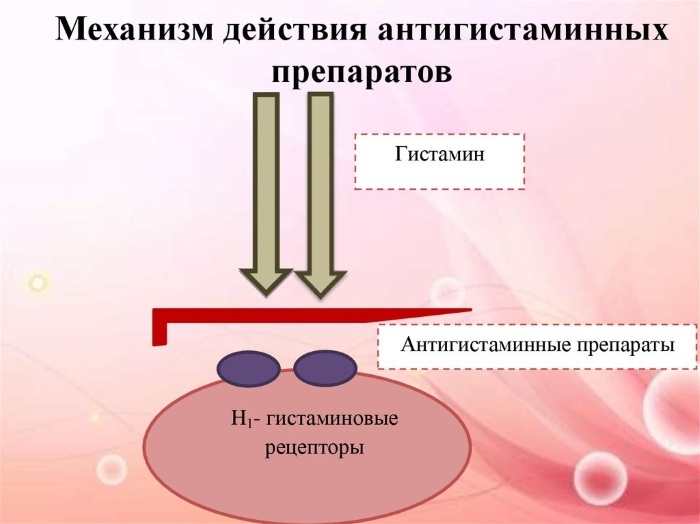
- Levocabastine - blocker H1-histamine receptors, which has a long-lasting effect. It is used to treat both seasonal and year-round allergic rhinitis. It should be borne in mind that the absorption of this component of nasal agents decreases with the simultaneous use of vasoconstrictor drugs (in particular, this applies to oxymetazoline). This compound has the same age limit for children.
- Olopatadin - also inhibits the release of biologically active substances that contribute to the development of the inflammatory process and edema of the nasal mucosa. The systemic impact is insignificant. It is not used in children under 3 years of age.
A group of substances related to glucocorticosteroids, described below, also has antihistaminic properties.
Glucocorticosteroids
Complex nasal drops for children containing glucocorticosteroids (or hormones) in the composition are recommended to be used in cases where rhinitis is severe (and in case of allergies - if antihistamines are ineffective).
Modern medicines significantly reduce itching, sneezing, eye symptoms, swelling of the mucous membranes and activity of the inflammatory process, while practically not absorbed into the bloodstream and have no systemic side effects effects.
They also do not affect the body's immune response and reduce the risk of developing complications such as rhinosinusitis, otitis media. Their disadvantages include the fact that a pronounced therapeutic effect does not appear immediately, but within a few days.
The following compounds can be used as such components:
- mometasone;
- fluticasone propionate and furoate;
- beclomethasone dipropionate;
- mometasone furoate.
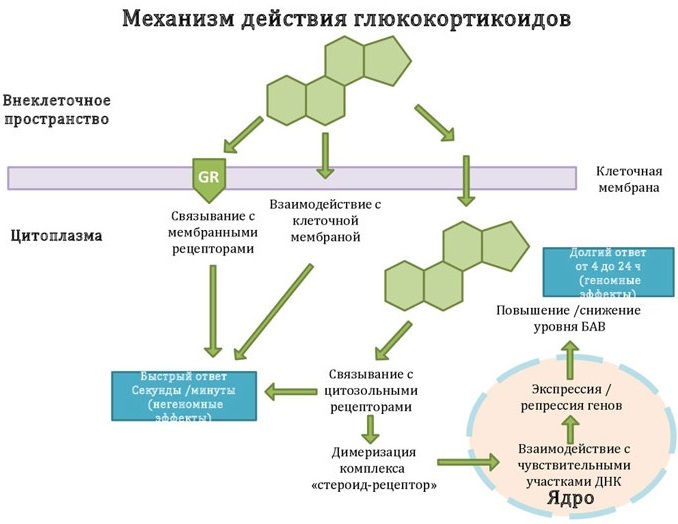
Mechanism of action of glucocorticosteroids
Fluticasone propionate and furoate, as well as mometasone furoate, have the least systemic effects. Long-term use of beclomethasone for 52 weeks leads to stunted growth in children, therefore, this substance is considered potentially dangerous in childhood.
Topical corticosteroids can be used to treat children as young as 2 years of age. After 2 weeks from the start of their use, the doctor should evaluate the effectiveness of therapy. In case of seasonal allergic rhinitis, these agents are prescribed 2-3 weeks before the beginning of the flowering of allergenic plants.
Immunomodulators
Since in most cases, infectious rhinitis is caused by rhinoviruses, the composition of multicomponent drops can include immunomodulators based on human interferon (nasal drugs Grippferon, Interferon, Genferon Light).
The following drugs also have antiviral effect:
- alpha glutamyl tryptophan (Timogen);
- sodium deoxyribonucleate (Derinat);
- arginyl-alpha-aspartyl-lysyl-valyl-tyrosyl-arginine (Imunofan);
- lysates of bacteria, or fragments of their cell walls, which stimulate innate immunity (IRS-19).
Saline
Saline, or in other words 0.9% sodium chloride solution, is used as a solvent for the preparation of many medicines. With rhinitis of various etiologies, it is prescribed for rinsing the nose. This helps to cleanse the nasal passages of mucus, microbes and allergens, as a result, the runny nose passes faster.
This solution is physiologically closest to biological fluids inside the human body. More concentrated formulations can dry out the mucous membrane, cause irritation, and glue the cilia in the nasal passages. Therefore, for washing, isotonic solutions are used that are safe for children and are used for a long time without side effects.
Additional components
Complex nasal drops for children, the composition of which is described earlier in the article, may also include the following components:
-
Colloidal solutions of silver ions. They have antibacterial, antifungal, antiviral effects. Silver ions reduce the activity of vital enzymes of microorganisms, disrupt the natural structure proteins, alter DNA replication and cause oxidative stress, which explains the suppression of infectious process. These drugs are Protargol and Sialor. They are used from the age of 3 years.
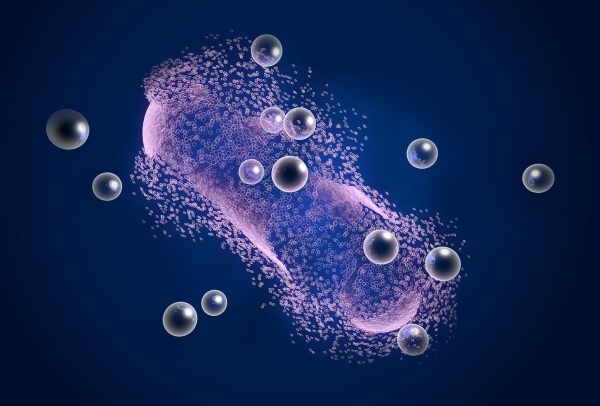
- Taurine - sulfur-containing amino acid, which normalizes metabolic processes in tissues, promotes faster restoration of the mucous membrane of the nasal cavity, damaged by the inflammatory process.
- Menthol, obtained synthetically or isolated from mint essential oil. This substance has mild anesthetic and antiseptic properties, reduces irritation, itching and makes nasal breathing easier.
- Dexpanthenol (vitamin B), which stimulates the restoration of damaged tissues, normalizes local metabolism, activates cell division and increases the strength of collagen fibers.
Indications for use in children
Compound drugs are prescribed in the following cases:
- with mixed infections (a combination of several pathogenic microorganisms);
- with chronic inflammatory processes and severe rhinitis, sinusitis, pharyngitis, adenoiditis;
- with a tendency to develop complications (otitis media, sinusitis and others).
When treating children, first of all, the safest drugs are used, and only if they are ineffective, multicomponent mixtures can be prescribed.
Side effects, contraindications
Side effects and contraindications depend on the characteristics of the composition of the drug.
So, the following restrictions on the use of drops in relation to their components can be noted:
- antibacterial agents - damage to the nasal septum (which manifests itself in the form of nosebleeds);
- vasoconstrictor - inflammatory process in the nose without mucus discharge, diabetes mellitus, chronic cardiac and renal insufficiency, hypertension and arrhythmia, hyperfunction of the thyroid gland, rhinitis in atrophic form, closed-angle glaucoma;
- preparations containing silver - children under 3 years of age, atrophic rhinitis;
- corticosteroids - age up to 2 years, nose injuries, exacerbation of chronic sinusitis;
- for all drugs - individual sensitivity to components.
When using these medications, the following side effects may occur:
- vasoconstrictor - dryness and burning in the nose and throat, mucosal atrophy (with prolonged use), palpitations, increased blood pressure, dizziness, headache, nausea;
-
hormonal components - nosebleeds, headache, irritation of the nasal mucosa (burning), with prolonged use - perforation of the nasal septum, growth retardation;
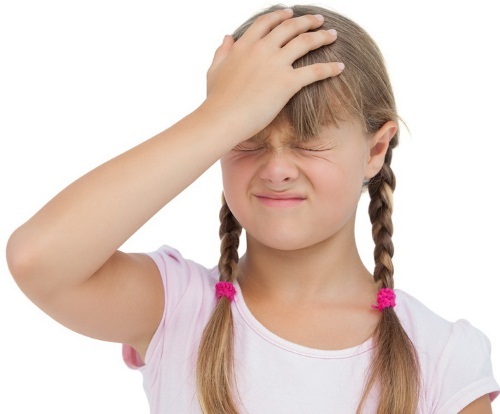
- for all drugs - allergic reactions.
Pharmaceutical compound drops
Complex nose drops for children, the composition of which is formed in the factory, are described in the table:
| Drug name | Main components | Indications | Average price, rub. |
| Polydexa | Dexamethasone, neomycin, polymyxin B, phenylephrine hydrochloride | Acute and chronic rhinitis, rhinopharyngitis; sinusitis (from 2.5 years old) | 390 |
| Sofradex | Framycetin, gramicidin, dexamethasone | Sinusitis, chronic rhinitis | 380 |
| Vibrocil | Phenylephrine, dimethindene | Acute and chronic rhinitis (allergic and vasomotor), sinusitis, otitis media in children over 1 year old. | 310 |
How to pick up a child?
When selecting medicines for composing drops, the following features must be taken into account:
- With allergic rhinitis, oral drugs begin to act within 1 hour, and intranasal drugs - after 15 minutes. At the same time, nasal drops are ineffective for allergic conjunctivitis, and the duration of their action is 2-3 times less than that of drugs for oral administration. In pediatric practice, the following drugs of this group are used: Allergodil (from 6 years old), Tizin Allerdzhi (from 6 years old), Kromohexal (from 5 years old).
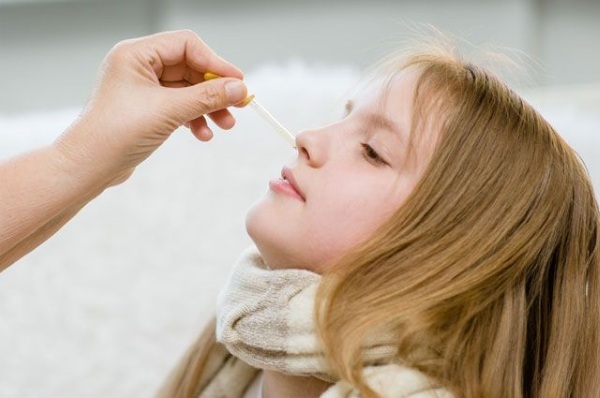
Hormonal nasal drops are addictive, so it's better not to abuse them! - Intranasal glucocorticosteroids used to reduce inflammation. They begin to take effect after 12 hours, and the maximum effect can be achieved only after a few days. These funds include: Nazonex (from 2 years old), Fliksonase (from 4 years old), Avamis (from 2 years old).
- Vasoconstrictors are used to relieve nasal congestion. They most quickly exert their effect (within 5-15 minutes). However, when they are used within 5-7 days, the effect decreases and a break is required. Long-term use of these drugs is not recommended due to the risk of side effects. For children, the following types of drugs can be used: Tizin (0.05% from 2 years old, 0.1% from 6 years old), Xylometazoline (from 2 years old), Sanorin (from 2 years old), Tizin (from 2 years old) and others.
Instructions for use
The drops are used in the following order:
- Wash your hands with soap and water.
- Clear mucus from the nasal passages. For this, it is recommended to use sea salt solutions (or saline). There are also simple and inexpensive nasal rinsing devices available from pharmacies.
- Lay the child on his back.
- If necessary, add a herbal component to the drops (aloe juice, Kalanchoe or others prescribed by a doctor).

- Instill 1-2 drops into each nasal passage (if a bottle is used without a dropper, then it must be purchased separately).
- Leave the child to lie down for 15-20 minutes. for penetration of the agent into the nose and distribution on the mucous membrane.
Recipes for the preparation of combined nasal solutions for children
The proportions of the components of the drops should be determined by the attending physician, depending on the nature of the disease and the above recommendations. When preparing solutions, it is necessary to strictly observe the recipe and the method of mixing them.
Compound drops can also be made according to the advice of traditional medicine. For this, components are used that have bactericidal activity (soda, iodine, sea salt, honey, essential oils), substances that have regenerative effect (sea buckthorn oil, aloe, mummy), as well as components that help moisturize the mucous membrane (sunflower or olive oil, glycerol).
They can also be mixed with pharmaceutical drugs.
With adenoiditis and microbial rhinitis
For inflammation of the pharyngeal tonsils and rhinitis associated with bacterial infection, the compositions indicated in the table are used:
| Components | Peculiarities |
| Collargol solution + glycerin | 2% - for children 2-12 years old, 3% - for children from 13 years old |
| Sofradex (2.5 ml) + Naphazoline (2.5 ml) | Sofradex already contains a hormonal component and 2 antibiotics. A vasoconstrictor component is added. |
| Saline (10 ml) + Xylometazoline (2.5 ml) + mometasone furoate (0.5 ml) + 0.5% novocaine solution (2 ml). | Anti-inflammatory, vasoconstrictor, analgesic effect. |
With adenoids and green snot in a child, you can use such recipes of traditional medicine as:
- In 1 st. Dissolve 1 tsp of warm boiled water. l. sea salt (no food additives). Then add 1 drop of iodine, mix. Rinse the nose with this compound 2 times a day (each nostril). This method can be used for older children.
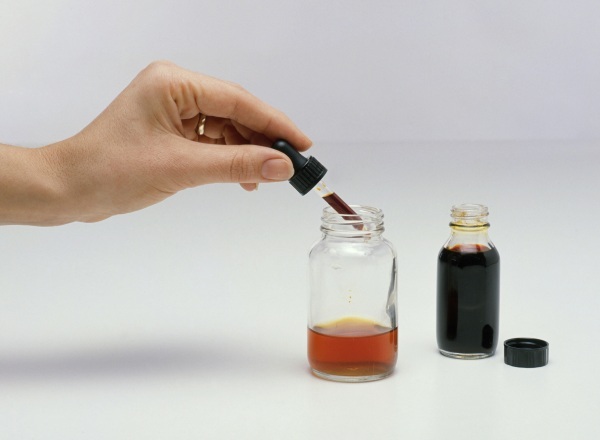
- In 1 st. Pour in boiled warm water ¼ tsp. l. baking soda, stir. Add 15 drops of 10% propolis tincture, stir again. With this mixture, you need to rinse your nose 3-4 times a day.
- In 1 st. boiled water dissolve 1 tbsp. l. sea salt, then add the same amount of honey. Strain the solution through cheesecloth. Rinse the nose with this tool, as in the previous case.
With sinusitis
With sinusitis, the following types of mixtures can be assigned:
- Sodium salicylate (pain reliever, 10 ml) + saline (20 ml) + borax (or sodium tetraborate, antibacterial component, 20 ml) + mint oil (2 drops). The mixture is diluted for ½ tsp. l. for 1 tbsp. water. 3-4 drops are instilled into the nose.
- 3% Prednisolone solution (1 ml) + 0.5% Novocaine solution (10 ml) + ascorbic acid (0.5 ml).
- Sulfacil sodium (2 ml, antibacterial component) + Thymogen (2 ml) + Xylometazoline (2 ml).
With sinusitis, you can also use folk recipes:
- Pour 2 tsp into a cup. l. warm boiled water and dissolve 10 mummy tablets in it. Add 1 tsp to the finished solution. l. glycerin. This composition should be instilled 1-2 drops 3 times a day. It is safe to swallow and is suitable for long-term use, not only for sinusitis, but also for persistent rhinitis.
- Mix 3 drops of geranium essential oil with 1 tbsp. l. sea buckthorn oil. Soak cotton wool turunda with this mixture and insert into the nostrils (one at a time) for 15 minutes. The procedure must be done 2 times a day.
- Mix 1 part of aloe and Kalanchoe pinnate juice, add 1/3 part of liquid honey. Instill 1-2 drops during the day 3-4 times a day.
For rhinitis with antiallergic effect
For allergic rhinitis, the following formulations can be used:
- Xylometazoline + Diphenhydramine (histamine receptor blocker);

- Diphenhydramine + aminocaproic acid (stops bleeding with dry mucosa) + Xylometazoline;
- Xylometazoline + Hydrocortisone + Diphenhydramine.
From folk recipes, the following can be cited:
- Add 3 drops of tea tree, lavender, sage, geranium to 30 ml of olive (or sea buckthorn) oil. This mixture must be instilled into the nose 1-2 drops 3-4 times a day. It is preliminarily recommended to check the absence of allergies - lubricate the elbow with this oil and wait about half an hour. If there are no rashes, then the product can be used. It is recommended to change the mixture every 5-7 days (it is enough to replace lavender with juniper or basil).
- Prepare a mixture of olive oil (20 ml) and St. John's wort oil (5 drops). The dosage is the same as in the previous case.
- Dissolve 1 g of mummy in 1 liter of water. Instill 1-2 drops into the nose 3-4 times a day, and also take 50 ml orally every morning.
Conditions and shelf life of multicomponent drops
The duration of storage of drugs depends on the presence of certain components in their composition.
So, the following features can be noted:
- an aqueous solution of mummy - no more than 10 days in the refrigerator;
- oil solutions (including those with essential oils) - 3 weeks (at room temperature);
- water solutions of plants (aloe, kalanchoe) - no more than 3 days (in the refrigerator);
- information on the composition and storage conditions is attached to the preparation made in a pharmacy.
Complex nasal drops in modern pharmaceuticals are most often used in the form of ready-made formulations that can be purchased in the pharmacy network.
For children, hormonal components are also provided that do not have a systemic effect. The production of special formulations in the prescription departments of pharmacies is the safest, as it is subject to precise dosage and aseptic conditions. In consultation with the attending physician, ingredients on a natural basis can also be used.
Video about nose drops
Recipe for effective nasal drops:



